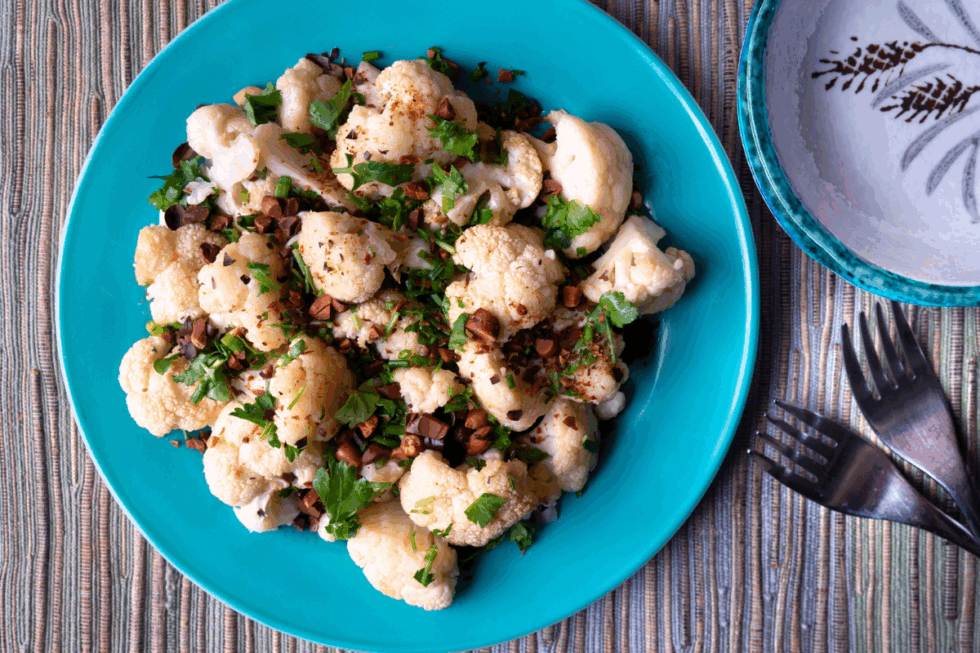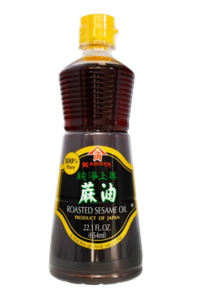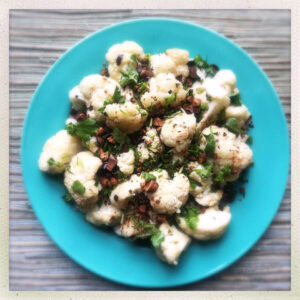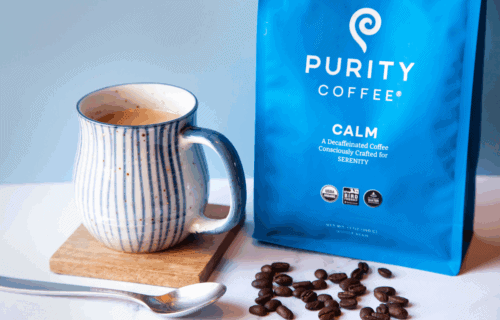
Sesame Cauliflower Low Histamine Side Dish (Low Histamine, Low Oxalate, Low Lectin)
This sesame cauliflower low histamine side dish combines the flavors of sesame, garlic, and ginger with the unique nuttiness of baruka nuts.
The low histamine recipe compliments easy chicken dinners as well as special occasion steak dinners.
(One of our taste testers may or may not have eaten half a recipe for lunch, on its own, too. 😊 But just to be clear, this is a side dish rather than a main meal.)
And don’t worry about baruka nuts if you have a nut allergy. Baruka nuts are actually seeds and not nuts at all!
This recipe is:
- Low histamine
- Low oxalate
- Low lectin
- Dairy free
- Gluten free
- Vegetarian
Keep reading to get the recipe and learn more about:
- Health benefits of cauliflower
- What is Oxalate Intolerance?
- Sesame seeds vs sesame oil – what to know about oxalate content
Health Benefits of Cauliflower
Before you change your diet on your own, please make sure you’re working with a healthcare practitioner who can help you with this. Never limit foods unnecessarily, and always have a licensed medical provider who is supervising your case.
With Histamine Intolerance, you’ll focus on eating low histamine foods and limiting high histamine foods.
In addition to choosing foods with low histamine content, you’ll want to emphasize healthy foods that support your body.
Fresh veggies are good sources of the vitamins and minerals your body needs.
Thankfully, there are more low histamine veggies than high histamine veggies!
Check out the Low Histamine Food List to find great options for low histamine foods to make part of your low histamine diet.
We use low histamine cauliflower in a lot of our recipes.
We’ve got cauliflower side dishes, cauliflower soup, and even a cauliflower hummus recipe.
Cauliflower also makes a great cauliflower rice or cauliflower mash (like mashed potatoes).
And when it comes to health benefits, cauliflower has lots to offer.
Cauliflower can support your health with:
- Antioxidant properties — cell health
- Quercetin — stabilizes mast cells, inhibits histamine release
- Vitamin C — immune health, activates DAO (diamine oxidase) the histamine degrading enzyme
- Fiber — digestive health
- Magnesium — anti-inflammatory properties, supports mast cells
Additionally, cauliflower may be helpful if you have estrogen dominance.
Diindolylmethane (DIM) is a compound found in cruciferous vegetables like cauliflower, broccoli, and cabbage.
DIM has been shown to help balance estrogen levels in the body.
These are all great reasons to add cauliflower to your meals.
Keep reading for our tasty sesame cauliflower low histamine side dish recipe.
But first, we want to answer one of your questions about sesame seeds and sesame oil regarding Oxalate Intolerance.
Sesame Seeds, Sesame Oil, and Oxalate Intolerance
When it comes to figuring out food intolerances, always talk with your healthcare professional before making dietary changes.
You don’t want to limit foods unnecessarily.
We talk the most about Histamine Intolerance.
But our recipes are always low to medium oxalate, too.
This helps accommodate those with Oxalate Intolerance.
What Is Oxalate Intolerance?
Oxalates are compounds found in plants. They are part of its defense system.
Under a microscope, they actually resemble razor blades!
Your body can make oxalates.
You may also be adding to your body’s oxalate load by eating plants high in oxalate content.
Oxalate Intolerance happens when the amount of oxalate present is too much for your body to handle.
An analogy we use is stepping on thorns.
Stepping on 1 thorn hurts. But it’s easy to remove. And you’ll be fine once it’s out.
But what if you stepped on 100 thorns at once every day for a week? And what if you couldn’t remove them?
Oxalate Intolerance is a bit like having hundreds of built-up thorns.
That’s why people with Oxalate Intolerance reduce high oxalate foods.
But it’s very important that you don’t stop eating high oxalate foods all at once!
That can result in something called oxalate dumping which can cause irritating and painful symptoms.
Related Article: What Is Oxalate Dumping?
Be sure to read the related article linked above to learn more about:
- Oxalate dumping
- Oxalate dumping symptoms
- Managing oxalates
- Supplements to bind oxalates
Next let’s look at a common question we get asked about Oxalate Intolerance and sesame seeds and sesame oil.
Sesame Seeds VS Sesame Oil
Sesame seeds are high oxalate. So, you might wonder why our sesame cauliflower recipe is low oxalate.
Most of the oxalate content of the sesame seed is in the hull.
And most of the hull is removed during the oil extraction process.
That results in a lower oxalate level in sesame oil than sesame seeds.
In this recipe, we used sesame oil for sesame flavor. And we used baruka nuts instead of sesame seeds for texture and taste.
Sesame oil is one of our favorite lower histamine ingredients.
We substitute sesame oil for high histamine ingredients like fish sauce and soy sauce.
We recommend a good quality sesame oil like the one below.

It pairs well with everything from meats to veggies.
And instead of sesame seeds, we’ve used ground baruka nuts.
We mentioned earlier that baruka nuts (also known as baru nuts) aren’t nuts at all. So, even if you have a nut allergy, baruka “nuts” should be fine for you.
Baruka nuts are actually seeds from the baruzeiro tree, native to Brazil.
You’ll find baruka nuts in some of our other low histamine recipes like the low histamine baruka nut vanilla mousse.
We love the nuttiness and toastiness that sesame oil and baruka nuts give to this cauliflower recipe.
This low histamine cauliflower recipe has minimal prep time.
Most of the time the recipe takes is inactive time.
That means once it’s in the oven, you can cook your main course. All you have to do is turn the cauliflower once or twice during the roast time to help ensure even cooking.
Serve the Sesame Cauliflower Low Histamine Side Dish With
- Chicken Marinade Skewers – Medium Oxalate, Low Lectin, Low FODMAP
- Pan Seared Filet Mignon Recipe – Low Oxalate, Low Lectin, with Low FODMAP option
- Rosemary Roasted Garlic Pork Chops – Low Oxalate, Low Lectin
- Turkey Breast with Cherries and Cranberries Low Histamine Sauce – Low Oxalate, Low Lectin

Sesame Cauliflower Low Histamine Side Dish
Equipment
- Sharp Knife
- Silicone Mat optional
- Garlic Press optional
Ingredients
- 1 Medium Cauliflower Head
- 1 Tablespoon Kasandrino’s Olive Oil
- 3 Tablespoons Toasted Sesame Oil
- ¼ teaspoon Redmond Real Salt
- ½ teaspoon Organic Fresh Ginger grated
- 2 Fresh Garlic Cloves minced
- ¼ cup Coconut Milk
- 1 Tablespoon Baruka (Baru) Nuts chopped
- 1 Tablespoon Fresh Organic Flat Leaf Parsley chopped
- 1 Tablespoon Fresh Organic Chives chopped
Instructions
- Preheat the oven to 375° F.
- Line your rimmed baking sheet with a silicone mat or parchment paper for easy cleanup.
- Cut the cauliflower into bite sized cauliflower florets. Discard leaves and excess cauliflower stems. Set aside.
- Mince the garlic and grate the ginger. Add to a medium mixing bowl.
- Add the sesame oil, extra virgin olive oil, coconut milk, and salt to the mixing bowl with the garlic and ginger.
- Toss the cauliflower in the mixture until evenly coated.
- Spread the cauliflower florets on your baking sheet.
- Roast in the oven for 30 minutes. Stir every 10 minutes with a spatula for even roasting. Cauliflower will be done when it is tender but not mushy.
- While the cauliflower is roasting, chop up the parsley, chives, and baruka nuts.
- When the cauliflower is finished, remove from the oven. Transfer to a serving bowl and top with parsley, chives, and baruka nuts. Add more salt to taste.
Notes
Nutrition
What will you serve this sesame cauliflower low histamine side dish with?
More Low Histamine Side Dishes
- Creamed Kale Recipe – Low Oxalate, Low Lectin
- Brussels Sprouts Shaved Salad with Garlic, Pecan, and Apple Dressing – Low Oxalate, Low Lectin, with Low Salicylate option
- Rutabaga Fries Recipe – Low Oxalate, Low Lectin, Low FODMAP, Low Salicylate
- Cherry and Arugula Salad – Low Oxalate, Low Lectin
- Broccoli Side Salad – Low Lectin, Low Oxalate
The website provides approximate nutrition information. Users should calculate the nutritional information with the actual ingredients and quantities they use in their recipes for the most accurate representation.
Some links in this website are affiliate links, which means Mast Cell 360 may make a very small commission if you purchase through the link. It never costs you any more to purchase through the links, and we try to find the best deals we can. We only recommend products that we love and use personally or use in the Mast Cell 360 practice. Any commissions help support the newsletter, website, and ongoing research so Mast Cell 360 can continue to offer you free tips, recipes, and info. Thank you for your support!
References
Ahmed, F. A., & Ali, R. F. (2013). Bioactive compounds and antioxidant activity of fresh and processed white cauliflower. BioMed Research International, 2013, 367819. https://doi.org/10.1155/2013/367819
Amini, M., et al. (2023). Effects of sesame dehulling on physicochemical and sensorial properties of its oil. Food Science & Nutrition, 11(10), 6596–6603. https://doi.org/10.1002/fsn3.3608
Beckstrand, R. L., & Pickens, J. S. (2011). Beneficial effects of magnesium supplementation. Journal of Evidence-Based Complementary & Alternative Medicine, 16(3), 181–189. https://doi.org/10.1177/2156587211401746
Carr, A. C., & Maggini, S. (2017). Vitamin c and immune function. Nutrients, 9(11), 1211. https://doi.org/10.3390/nu9111211
FoodData Central. (n.d.). https://fdc.nal.usda.gov/fdc-app.html#/food-details/169986/nutrients
Fu, J., et al. (2022). Dietary fiber intake and gut microbiota in human health. Microorganisms, 10(12), 2507. https://doi.org/10.3390/microorganisms10122507
HappyForks. (n.d.). Recipe analyzer. https://happyforks.com/analyzer
Li, Y., et al. (2016). Quercetin, inflammation and immunity. Nutrients, 8(3), 167. https://doi.org/10.3390/nu8030167
Rajoria, S., et al. (2011). 3,3′-diindolylmethane modulates estrogen metabolism in patients with thyroid proliferative disease: a pilot study. Thyroid: Official Journal of the American Thyroid Association, 21(3), 299–304. https://doi.org/10.1089/thy.2010.0245
Veronese, N., et al. (2022). Effect of magnesium supplementation on inflammatory parameters: A meta-analysis of randomized controlled trials. Nutrients, 14(3), 679. https://doi.org/10.3390/nu14030679




Add A Comment